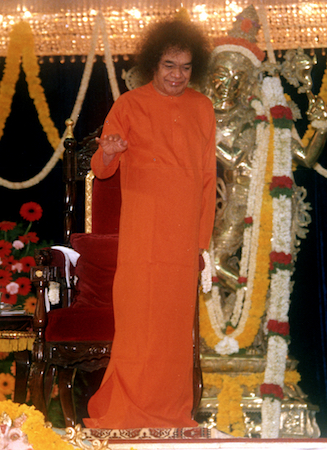azhagi.com/baba - 100s of 'Thought for the Day' nectars of beloved Bhagawan Sri Sathya Sai Baba - translated from English to Tamil by an ardent devotee - typed using Azhagi
Date: Monday, 22 May 2023 (As it appears in 'Prasanthi Nilayam')

Date: Monday, 22 May 2023 (As it appears in 'Prasanthi Nilayam')

Take the hymn that describes Krishna - "Kasturi tilakam". Outwardly, it delineates the beautiful form and describes His ornaments. But each word has a deeper significance which should not be missed. The tilakam or dot of Kasturi or musk on the forehead of Krishna is the symbol of the Eye of Wisdom, the Inner Eye, the inward-directed vision, like the third eye on the forehead of Shiva. Kasturi means jnanam or wisdom. Then the hymn speaks of the Kaustubha gem on the chest. It indicates the ananda in the heart, the untarnished bliss of the Lord who is bliss personified. Next is the shining pearl on Krishna's nose-ring. Well, the Navamouktikam on His nasagra (nose-tip) is indicative of the success that follows one-pointed concentration on His Glory for which the tip of the nose is considered by adepts in yoga as a point of help. Pearl is produced out of the raindrop, from the first, pure, unsullied showers that is swallowed by the oyster waiting long for the precious gift from heavens. This indicates the transforming effect of yearning and natural thirst for the pure and the true! (Divine Discourse, Jan 30, 1965)
Whenever you see the Flute in the Lord’s hand, remember to make oneself into a hollow reed, with no trace of material greed. – BABA
கிருஷ்ணரை வர்ணிக்கும் ‘கஸ்தூரி திலகம்’ என்று தொடங்கும் ஸ்லோகத்தை எடுத்துக் கொள்ளுங்கள். வெளிப்படையாகப் பார்த்தால் அது அவருடைய அழகான ரூபத்தையும் ஆபரணங்களையும் வர்ணிப்பதைப் போன்று இருக்கிறது. ஆனால் ஒவ்வொரு வார்த்தைக்கும் உள்ள ஆழமான உட்பொருளை நாம் அறிந்து கொள்ளத் தவறக்கூடாது. கிருஷ்ணரின் நெற்றியில் உள்ள கஸ்தூரிப் பொட்டு, சிவனின் நெற்றிக் கண்ணைப் போன்று ஞானக்கண், அகக்கண், உள்நோக்கிய பார்வை ஆகியவற்றின் சின்னமாக விளங்குகிறது. பின்னர் அந்த ஸ்லோகம் அவருடைய திருமார்பில் உள்ள கௌஸ்துப மணியைப் பற்றி விளக்குகிறது. இது பேரானந்த ஸ்வரூபனான இறைவனின் இதயத்தில் உள்ள குன்றாத ஆனந்தத்தைக் குறிக்கிறது. அடுத்து கிருஷ்ணரின் புல்லாக்கில் ஜொலிக்கும் முத்து. அவருடைய நாசியின் நுனியில் உள்ள நவமௌக்திகம் எனும் முத்து, ஒருமுனைப்போடு இறைவனின் மகிமையைத் தியானிப்பதால் பெறப்படும் வெற்றியைக் குறிக்கிறது. மூக்கின் நுனியில் பார்வையை நிலைநிறுத்தி தியானிப்பது யோகப் பயிற்சிக்கு ஏற்றதென்று யோகிகளால் கருதப்படுகிறது. விண்ணிலிருந்து பொழியும் உயிர்த்துளியான தூய்மையான அப்பழுக்கற்ற முதல் மழைத்துளிக்காக முத்துச்சிப்பி வெகுகாலம் காத்திருந்து, அதை உட்கொண்டபின் முத்தை உற்பத்தி செய்கிறது. தூய்மை மற்றும் சத்தியத்திற்கான இயல்பான தாகமும் ஏக்கமும் ஏற்படுத்தும் நல்மாற்றத்தையே இது குறிக்கிறது. (தெய்வீக அருளுரை,ஜனவரி30, 1965)
இறைவனின் கையில் உள்ள புல்லாங்குழலைப் பார்க்கும் போதெல்லாம், பொருளாசையின் சுவடேதுமில்லாத ஒரு வெற்றுக் குழலாக நம்மை மாற்றிக்கொள்ள வேண்டும் என்பதை நினைவுபடுத்திக் கொள்ளுங்கள். - பாபா



 24 languages . Tamil, Hindi, Arabic, etc . Never before seen features . Extendable to type in any Language Font Keyboard . Changeable key mappings . Voice input in Android . And more...
24 languages . Tamil, Hindi, Arabic, etc . Never before seen features . Extendable to type in any Language Font Keyboard . Changeable key mappings . Voice input in Android . And more...




















































































































